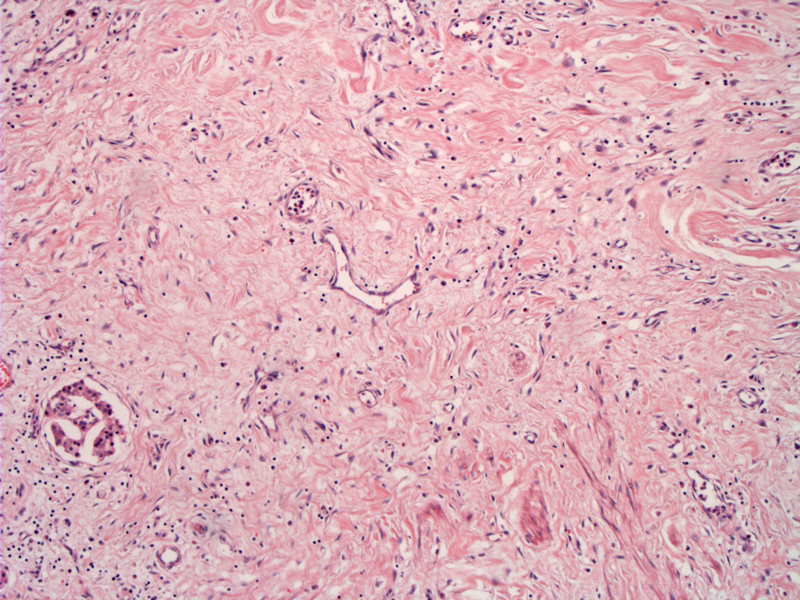

Author: Cecilia Wu, MD, Resident, Dept of Pathology, University of New Mexico
Co-author(s): Lisa Cerilli, MD, Faculty, Dept of Pathology, University of New Mexico
Extensive fibrosis has replaced the pancreatic parenchyma. There are scattered lymphocytes.
Islets of Langerhans are the only residual cells. They are surrounded by fibrosis.
Lymphoid aggregates are present (upper left) and a lonesome duct with an irregular outline is seen (right). Note that irregular dilated ducts and fibrosis may simulate well-differentiated infiltrating ductal carcinoma, which must be on your differential.
Chronic pancreatitis is an inflammatory condition often due to excessive alcohol use that ultimately leads to endocrine and exocrine insufficiency. The main difference between acute and chronic pancreatitis is that the damage in chronic pancreatitis is irreversible.
Histologically, it is characterized by loss of pancreatic parenchyma (namely, reduced number and size of acini), which is replaced by fibrosis. A chronic inflammatory infiltrate consisting of lymphocytes, plasma cells and occasional neutrophils is present. Dilated ducts containing inspissated eosinophilic material (mucoprotein plugs) are also characteristic. Note that the islets of Langerhans are often spared, but in severe instances, the islets can be destroyed as well.1,2
Chronic pancreatitis affects males more than females and presents with diabetes mellitus, malabsortpion with steatorrhea and weight loss due to loss of endocrine and exocrine functions. Patients have bouts of abdominal pain of varying intensity.
It is most commonly attributed to alcohol abuse in the United States, although pancreatic duct obstruction from stones or tumors, hereditary pancreatitis due to germ line mutations, metabolic derangements such as hypercalcemia may also lead to chronic pancreatitis.1,2
Supportive therapy with pancreatic enzyme replacement and management of diabetes.
Long-term prognosis is poor, with a 20-25 year mortality rate of 50%. Complications include development of pseudocysts (predisposing to infection) and possibly carcinoma. Although the lifetime risk of developing pancreatic cancer in hereditary pancreatitis is reported to be 40%, the risk of chronic pancreatitis from other etiologies is not known as this time.1
The number one cause of chronic pancreatitis in the US is alcohol abuse.
It is defined as irreversible loss of pancreatic tissue, leading to endocrine and exocrine insufficiency.
Fibrosis, loss of acini with sparing of islets of Langerhans, ductal dilatation, and a chronic inflammatory infiltrate are key microscopic features.
• Pancreas : Acute Pancreatitis
• Pancreas : Ductal Adenocarcinoma
1 Kumar V, Abbas AK, Fausto N. Robbins and Cotran Pathologic Basis of Disease. 7th Ed. Philadelphia, PA: Elsevier; 2005: 945-6.
2 Iacobuzio-Donahue CA, Montgomery EA. Gastrointestinal and Liver Pathology: Foundations in Diagnostic Pathology. Philadelphia, PA: Elsevier; 2005: 468-471.